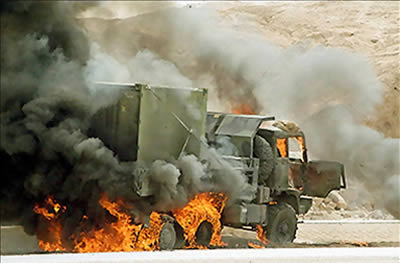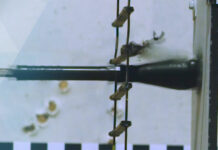A new type of IED consists of “shaped charge”, located under the road surface or at the side of the road. In these explosive devices, a cone (also known as concave) made of copper is covering an explosive charge creating a hollow space in front of and along the axis of the charge.
When the explosive is activated, the copper transforms into a forceful jetstream of molten metal also known as “plasma”. This plasma jet easily perforates an unprotected steel armor, hitting the surface at a speed of 8,000 meters per second and extremely high pressure. If the plasma is not obstructed by a target within few meters, it solidifies into a kinetic slug which is less effective against heavy armor but is still devastating against softer targets.  In both cases, the effect inside the target interior can be catastrophic, especially if it ignites unprotected ammunition stores, causing secondary explosions. Anti-tank shaped charges must be employed with utmost accuracy (activation distance, and design accuracy). Therefore, they are used primarily with buried mines, and lightweight anti-tank weapons.
In both cases, the effect inside the target interior can be catastrophic, especially if it ignites unprotected ammunition stores, causing secondary explosions. Anti-tank shaped charges must be employed with utmost accuracy (activation distance, and design accuracy). Therefore, they are used primarily with buried mines, and lightweight anti-tank weapons.
Heavier IEDs which utilize the heavy slug concept can be used with roadside ambushes, detonating at a standoff distance from the target, inflicting devastating effect and fragmentation on the protected and light armored targets and their surrounding. To be most effective, the shaped charge has to be detonated at the right distance from the target. If it detonates too close to the steel armor, an optimal plasma jet cannot be formed dissipating the penetration effect. If detonated too far from the armor, the plasma jet is already unfocused and partly spent itself.
Additional parts of this article:
- IED – Shaped Charges
- IED – Shaped Charges part II
- Shaped Charges IED in the Middle East
- Protection Against Shaped Charge IEDs – The Israeli Experience




















